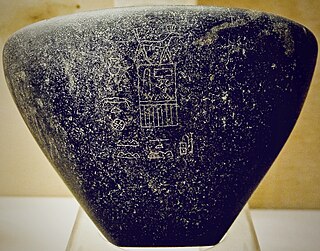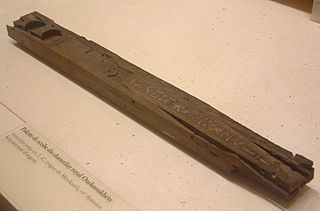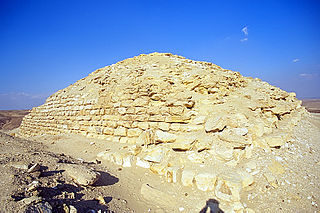
Narmer (Ancient Egyptian: nꜥr-mr, meaning "painful catfish," "stinging catfish," "harsh catfish," or "fierce catfish;" was an ancient Egyptian pharaoh of the Early Dynastic Period. He was the successor to the Protodynastic king Ka. Many scholars consider him the unifier of Egypt and founder of the First Dynasty, and in turn the first king of a unified Egypt. He also had a prominently noticeable presence in Canaan, compared to his predecessors and successors. A majority of Egyptologists believe that Narmer was the same person as Menes. Neithhotep is thought to be his queen consort or his daughter.

Huni was an ancient Egyptian king and the last pharaoh of the Third Dynasty of Egypt during the Old Kingdom period. Following the Turin king list, he is commonly credited with a reign of 24 years, ending c. 2613 BC.

Khakheperre Senusret II was the fourth pharaoh of the Twelfth Dynasty of Egypt. He ruled from 1897 BC to 1878 BC. His pyramid was constructed at El-Lahun. Senusret II took a great deal of interest in the Faiyum oasis region and began work on an extensive irrigation system from Bahr Yussef through to Lake Moeris through the construction of a dike at El-Lahun and the addition of a network of drainage canals. The purpose of his project was to increase the amount of cultivable land in that area. The importance of this project is emphasized by Senusret II's decision to move the royal necropolis from Dahshur to El-Lahun where he built his pyramid. This location would remain the political capital for the 12th and 13th Dynasties of Egypt. The king also established the first known workers' quarter in the nearby town of Senusrethotep (Kahun).

Iry-Hor was a predynastic pharaoh of Upper Egypt during the 32nd century BC. Excavations at Abydos in the 1980s and 1990s and the discovery in 2012 of an inscription of Iry-Hor in the Sinai confirmed his existence. Iry-Hor is the earliest ruler of Egypt known by name and is sometimes cited as the earliest-living historical person known by name.

Seth-Peribsen is the serekh name of an early Egyptian monarch (pharaoh), who ruled during the Second Dynasty of Egypt. His chronological position within this dynasty is unknown and it is disputed who ruled both before and after him. The duration of his reign is also unknown.

Ka, also (alternatively) Sekhen, was a Predynastic pharaoh of Upper Egypt belonging to Dynasty 0. He probably reigned during the first half of the 32nd century BC. The length of his reign is unknown.

Neferuptah or Ptahneferu was a daughter of the Egyptian king Amenemhat III of the 12th Dynasty. Her sister was the Pharaoh Sobekneferu.

The Gebel el-Arak Knife, also Jebel el-Arak Knife, is an ivory and flint knife dating from the Naqada II period of Egyptian prehistory, showing Mesopotamian influence. The knife was purchased in 1914 in Cairo by Georges Aaron Bénédite for the Louvre, where it is now on display in the Sully wing, room 633. At the time of its purchase, the knife handle was alleged by the seller to have been found at the site of Gebel el-Arak, but it is today believed to come from Abydos.

Merikare was an ancient Egyptian pharaoh of the 10th Dynasty who lived toward the end of the First Intermediate Period.
Purportedly inspired by the teaching of his father, he embarked on a semi-peaceful coexistence policy with his southern rivals of the 11th Dynasty, focusing on improving the prosperity of his realm centered on Herakleopolis instead of waging an open war with Thebes. His policy was not rewarded, and shortly after his death his kingdom was conquered by the Theban Mentuhotep II, marking the beginning of the Middle Kingdom. The existence of his pyramid has historically been ascertained, although it has not yet been discovered.

Sekhemre Sementawy Djehuti was possibly the second king of the Theban 16th Dynasty reigning over parts of Upper Egypt during the Second Intermediate Period. Alternatively, he may be a king of the late 13th Dynasty or the fourth king of the 17th Dynasty. Djehuty is credited with a reign of 3 years in the first entry of the 11th column of the Turin canon. According to Egyptologists Kim Ryholt and Darrell Baker, he was succeeded by Sobekhotep VIII.
Senusret IV Seneferibre was an ancient Egyptian Theban king during the late Second Intermediate Period that is attested only through finds from Upper Egypt. The chronological position of Senusret IV is unclear and even the dynasty to which he belongs is debated.
The Southern South Saqqara Pyramid is an ancient Egyptian royal tomb which was built during the 13th Dynasty in South Saqqara, and is renowned for having the most elaborate hypogeum since the late 12th Dynasty pyramids. The building remains unfinished and its owner is still uncertain as no unambiguous evidence has been found to settle the issue. In 2008, the Egyptologist Christoffer Theis proposed that the pyramid was built for king Djehuti, based on a inscription discovered nearby by Gustave Jéquier.

The pyramid of Athribis was a small mudbrick pyramid, which was located at Athribis in the southern Nile Delta, northeast of the modern city of Banha. It was located the furthest north of all the pyramids in ancient Egypt and the only known pyramid to have been built in the Delta.
The pyramid of Elephantine is part of a group of seven very similar small step pyramids, along with the pyramids at Edfu South, el-Kula, Naqada, Saujet el-Meitin, Seila, and Sinki. All of these were built far from the main centres of Egypt and are very poorly understood. The pyramid of Elephantine is located in the northwest part of the Old Kingdom city on the south end of the island of Elephantine in the Nile. The structure was discovered in 1907, but it could only be identified as a pyramid after excavations by the German Archaeological Institute in 1978–79.
The Edfu South pyramid is part of a group of seven very similar small step pyramids which were all built far from the main centres of Egypt and about which very little is known, along with the pyramids of Elephantine, el-Kula, Naqada, Saujet el-Meitin, Sinki and Seila. It is located about five kilometres south of Edfu near Naga el-Ghoneimeya. It was first identified as a pyramid in 1979, when the German archaeologists Günter Dreyer and Werner Kaiser were leading a survey of Edfu after a tip off from the inspector. Further investigation and surveys of the surrounding area have been undertaken since 2010 by the Oriental Institute of the University of Chicago.

Ancient Egyptian pottery includes all objects of fired clay from ancient Egypt. First and foremost, ceramics served as household wares for the storage, preparation, transport, and consumption of food, drink, and raw materials. Such items include beer and wine mugs and water jugs, but also bread moulds, fire pits, lamps, and stands for holding round vessels, which were all commonly used in the Egyptian household. Other types of pottery served ritual purposes. Ceramics are often found as grave goods.

Ny-Hor was a possible pharaoh from the Predynastic Period. His name means "The Hunter" according to egyptologist Werner Kaiser. He may have ruled during the 31st century BC.

The pyramid of Seila is one of a group of seven small step pyramids which are very similar to one another, along with the Edfu South pyramid, the pyramid of Elephantine, the pyramid of El-Kula, the pyramid of Naqada, the pyramid of Saujet el-Meitin, and the pyramid of Sinki. These pyramids were all built far from the major centres of Egypt and very little is known about them. The pyramid is located on an outcrop between the Faiyum Oasis and the Nile Valley, about 6 km north of the motorway from Wasta to Faiyum. Its builder may have been Snefru, the founder of the Fourth Dynasty. It was discovered in 1889/1890 by Flinders Petrie and revisited in 1898 by Ludwig Borchardt.

Black-topped pottery is a specialized type of Ancient Egyptian pottery that was found in Nubian archaeological sites, including Elephantine, an island on the Nile River, Nabta Playa in the Nubian Desert, and Kerma in present-day Sudan. This type of artifact dates predominantly to the Predynastic Period, but “a handful of examples made in the Early Dynastic Period are known to exist.” These vessels were used “exclusively for ritual and funerary purposes” and were discovered in ancient cemeteries and settlements. The majority of these pots are variations of the Egyptian hes-jar form and feature red bodies with black tops and interiors. The red color is derived from the natural iron that occurs within Nile silts which oxidizes upon firing, and the black top and interior is a product of reduction firing and carbon smudging.

The Pyramid of el-Kula, along with the pyramids in Edfu-South, Elephantine, Ombos, Saujet el-Meitin, Seila, and Sinki, belongs to a group of seven very similar small step pyramids that were all built far away from the major centers of Egypt and about which very little is known. It is located approximately six kilometers north of the ancient site of Hierakonpolis near the village of Naga el-Mamariya. Of all the pyramids mentioned above, it is in the best state of preservation. It was first described in 1837 by John Shae Perring and Richard William Howard Vyse, who called it el-Koofa. A thorough excavation and examination of the structure was carried out in 1949 under the direction of the Belgian Egyptologist Jean Capart.
















